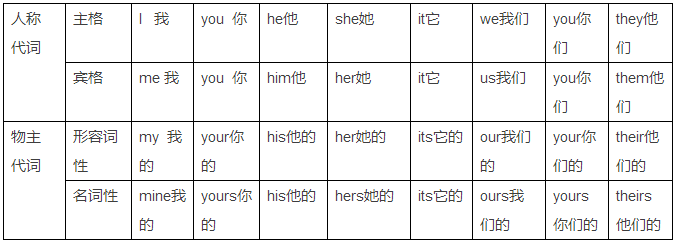|
期末考试快要到了,为了帮助初一的同学们在最后的一个月里充分备考,小编为大家整理了各科知识点,希望能够帮助到大家!期末考试不仅是对本学期学习情况的检测,也是要求同学们对本学期知识的全面整理,所以大家一定要重视哦!  1. 人称代词和物主代词  1) 人称代词作主语时用主格;作宾语时用宾格;作表语时用主格或宾格,但在口语中常用宾格。 ① I(作主语)am hungry, please give me(作宾语)something to eat. 我饿了,请给我一些吃的东西。 ② I like her, and she likes me , too. 我喜欢她,她也喜欢我。 ③ Who told him that news? 谁告诉他那个消息的? ④ It’s me/I. 是我。 2) 并列人称代词的排列顺序:人称代词在并列使用时,单数的顺序是第二人称→第三人称→第一人称;复数的顺序是第一人称→第二人称→第三人称。 you, he, and I 你,我,他 you and I我和你 he and I 我和他 you and he 你和他 we and you 我们和你们 you and they 你们和他们 we, you and they我们,你们和他们 3) 形容词性物主代词修饰名词,必须放在名词前面,相当于形容词,在句中作定语。名词性物主代词相当于名词(即指代名词,后面不能再加名词),在句中作主语、表语或宾语。 This is your ruler, it is not mine.这是你的尺子,不是我的。 2. Is this/that...? 这/那是......吗? Yes, it is. / No, it isn’t. 是的,这/那(它)是。/ 不,这/那(它)不是。 △回答时,要用it来代替this和that。不可回答Yes, this/that is. / No, this/that isn’t. 1)Is this your pencil ?这是你的铅笔吗? Yes, it is. It’s mine是的,它是我的(铅笔)。 No, it isn’t. It’s hers. 不,不是的。这是她的(铅笔) 2)Is that your schoolbag? 那是你的书包吗? Yes, it is. It’s mine. 是的,它是我的(书包)。 No, it isn’t. It’s his. 不,不是的。那是他的(书包) It’s = It is isn’t = is not 3. Are these/those… ? 这/那些是……吗? Yes, they are. / No, they aren’t. 是的,这/那些(它们)是。/ 不,这/那些(它们)不是。 △回答时,要用they来代替these和those。不可回答Yes, these / those are / No, these / those aren’t. 1) Are these your books? 这些是你的书吗? Yes, they are.是的,这些(它们)是。 No, they aren’t. They are hers. 不,这些(它们)不是。这些是她的(书)。 2) Are those her keys? 那些是她的钥匙吗? Yes, they are.是的,那些(它们)是。 No, they aren’t. They are mine. 不,那些(它们)不是。那些是我的(书)。 aren’t = are not 4. Excuse me. 请原谅/打扰了(客套语,用于问别人问题、请别人帮忙、打断别人说话等场合。) Sorry/I’m sorry. “对不起,抱歉”(用于向别人表示歉意) A: Excuse me. Where is my pen? 打扰了,我的钢笔在那? B: Sorry/I’m sorry, I don’t know. 对不起,我不知道。 5. What / how about …? “……怎么样?” “……又如何呢?”。后接名词,代词或动名词。 1)向对方提出建议或请求。例如: How about going out for a walk? 出去散散步好吗? What about another cake? 再吃块蛋糕好吗? 2)征询对方的看法或意见。例如: What about her playing the violin? (你认为)她的小提琴拉的怎么样? What about the TV play? 那个电视剧怎么样? 3) 询问天气或身体等情况。例如: What about the weather in your home town? 你们家乡的气候如何? How about your uncle now? You can’t leave him by himself. 你叔叔近来身体好吗?你们不能单独让他生活。 4) 寒暄时用作承接上下文的转折语。例如: I am from Beijing. What about you? 我是北京人,你呢? 5) 对所陈述的情况做出反诘,常给予对方一种暗示。例如: ——My memory is good. I’ve never forgotten anything.我的记忆力很好,从不忘记什么。 ——What about that time you left your key to the office at home?那次你将办公室的钥匙忘在家里算是怎么回事呀? 6. thanks / thank you for... 因......而感谢 for是介词,后接n/pron/v-ing. (名词、代词、动名词) Thanks for the photo of your family. 谢谢你的全家福照片。 Thanks for helping me. 谢谢你帮助我。 Thank you for your help. 谢谢你的帮助。 7. 如何用英语表示感谢 1)表示感谢的常用套语: It‘s very kind of you. 你太好了,多谢你了。 Thank you. 谢谢你。 Thank you very much. 非常感谢。 Thank you very much indeed. 真是太感谢你了。 Thanks. 谢谢。 Thanks a lot. 多谢。 Thanks very much. 非常感谢。 Thanks so much. 非常感谢。 Many thanks. 多谢。 2)回答感谢的常用答语: Not at all. 别客气;不用谢;哪儿的话。 You are welcome. 不用谢。 That‘s all right. 没什么;不用谢。 That‘s OK. 没什么;不用谢。 Please don‘t mention it. 不用客气;不用谢。 It‘s [It was] a pleasure. 不用客气;不用谢。 A pleasure. 不用客气;不用谢。 It is (was) my pleasure. 别客气,这是我高兴做的。 My pleasure. 不客气,这是我高兴做的事。 No problem. 不客气;不用谢。 It‘s [It was] nothing. 没什么;不客气。 8. How do you spell...? 你怎么拼写/读……? A: How do you spell“red”? B: R-E-D. 用于询问或要求对方拼写单词的表达方式还有: Spell it, please. 请把它拼写出来。 Can you spell it, please? 请把它拼写出来好吗? Do you know how to spell it? 你知道它如何拼写吗? 9. ask for…. 请求/要…… 如:I’ll ask for two pencils. 我将要两支铅笔。 ask sb for sth 向某人请求/要某物 ask the teacher for help 向老师求助 10. call sb at + 电话号码:“拨打......号码找某人” Call Alan at 495-3539.拨打495-3539找艾伦 11. E-mail me at maryg2@gfimail.com. (请)给我maryg2@gfimail.com这个邮箱发邮件。 1)at 放在电子邮箱的地址或电话号码等前面,表示“根据……;按照……” 2)@是at的缩写,读作at.com前的实心点读作dot。 12. I must find it. 我必须找到它。 13. a set of... 一套/副/串...... a set of keys 一串钥匙 a set of...作句子的主语时,应看作一个整体,谓语动词用单数。如: A set of keys is on the desk. 有串钥匙在桌子上。 14. Is that your computer game in the lost and found case? 那个在失物招领箱里的电子游戏机是你的吗? in the lost and found case 在失物招领箱里 (责任编辑:admin) |
